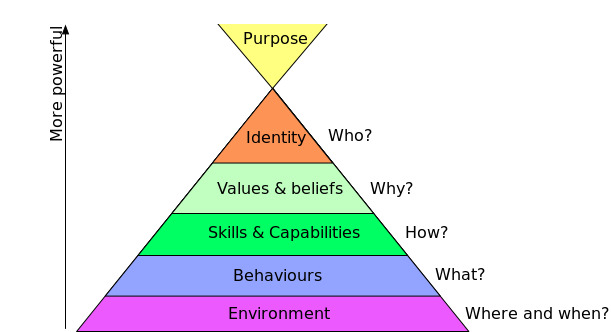The Logical Levels represent interconnected layers of life, each building upon the other, where challenges, solution strategies, and goals can be identified. Changes at a higher level often influence and bring about changes at lower levels.
The Seven Levels of Logic
Our actions, existence, goals, and challenges can be associated with various levels of life. For instance, we can directly impact our surroundings, adjust our behavior, or acquire new skills. Alternatively, we can transform our beliefs or redefine our sense of identity.
The various aspects of our life can be arranged into a hierarchical framework, where each level encompasses and impacts the ones below it. These are categorized into seven tiers, known as the Logical Levels:
- Environment
- Behavior
- Capabilities
- Values/Beliefs
- Identity
- Belonging
- Spirituality/Higher Purpose

In our daily lives, we are generally more aware of the lower levels than the higher ones. However, the less conscious levels tend to have greater influence and impact. In essence, the higher the level, the more unconscious and influential it becomes.
Interconnections Among the Levels
The various levels can help identify where goals, challenges, and tasks are situated. Moving mentally to a higher level can often be beneficial, as it provides access to new resources and broader options.
For instance, I can alter my environment (level 1) by adjusting my behavior (level 2), which can be modified through learning new skills (level 3). Similarly, changing my identity (e.g., by pursuing a new career, level 5) can reshape my values and beliefs (level 4), which will subsequently impact the skills I choose to develop (level 3).
Changes at higher levels often lead to shifts at lower levels, as the higher levels encompass and influence those below. Additionally, higher levels are more closely tied to our sense of meaning, making changes easier and more sustainable when they align with what feels meaningful to us.
Below is a detailed description of each specific level:
1. Environment
Where? When? With whom?
The environmental level encompasses our surroundings, including other people, objects, and physical forces. It represents all external conditions in our immediate environment that influence or affect us.
2. Behavior
What are you doing? What can others observe?
The behavioral level includes your specific actions, activities, and operations. It encompasses everything that can be observed by others and that occurs in real time. This includes your facial expressions, gestures, movements, reactions, choice of words, and even your breathing patterns.
3. Capabilities
How do you do it? What skills do you have? What is your strategy?
The capabilities level refers to your competencies, skills, and the strategies you employ. It encompasses all the internal processes that enable specific observable behaviors. These include mental, reflexive, and emotional abilities that you acquire and develop throughout your life.
4. Values and Beliefs
What for? Why? What’s the point? What do you believe in? What do you stand for?
The values and beliefs level encompasses your principles, guiding ideas, and the truths you hold as important. It includes the core beliefs that shape your behavior and drive your motivation. This level also influences what you consider possible, what feels right to you, and what you permit yourself to think or pursue.
5. Identity
Who are you? How do you describe someone like you?
The identity level represents your self-image, core values, responsibilities, and life mission—everything connected to “I am…” and what defines you as a person. It includes the roles you embody, such as mother, father, friend, or professional, as well as central qualities like being a source of strength, inspiration, or guidance to others.
6. Belonging
What do you feel connected to? Who do you belong to?
The belonging level encompasses the groups and social systems you identify with. These can include your family, sports teams, religious communities, nations, or even larger entities like continents, humanity, the universe, nature, or the divine. This level represents everything that connects you to something greater and transcends your individual self.
7. Spirituality and Higher Purpose
What is the meaning of life? What does it all mean?
The spirituality level reflects your understanding of the meaning and purpose of your life and the vision for your existence. It serves as a guiding force, providing a foundation for your being while offering security, a sense of connection, and a deeper sense of meaning.
When confronted with a specific problem, the desire for change, or the need to set new goals, consider which of the seven levels is most relevant to the situation. Reflect on whether higher levels could also play a role. How might changes at those higher levels influence the level where your problem, change, or goal is situated? This approach can reveal deeper connections and unlock new perspectives or solutions.
You can explore these questions with your coach in an upcoming session. Together, you can identify which levels certain challenges and their solutions are connected to, gaining clarity and direction for addressing them effectively.